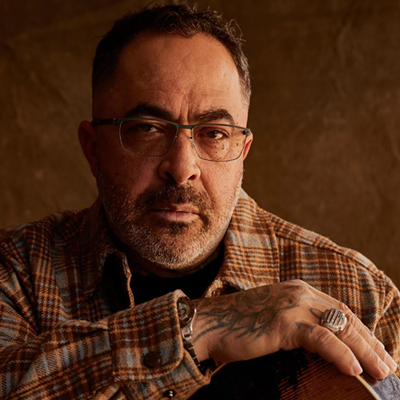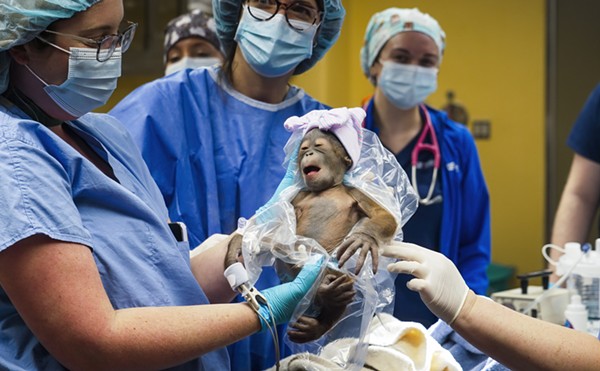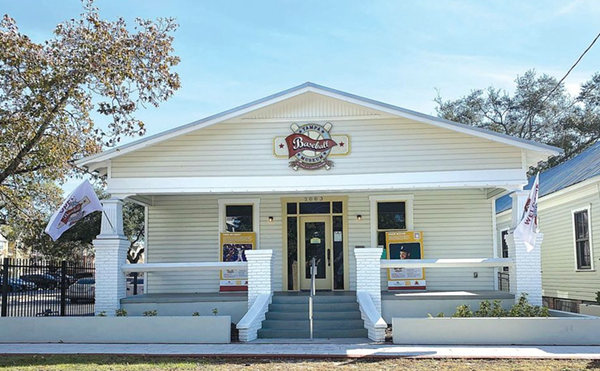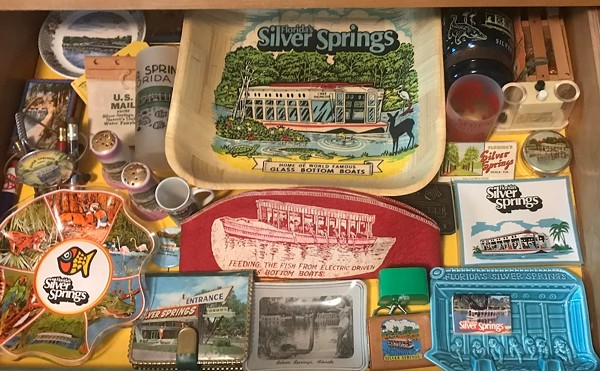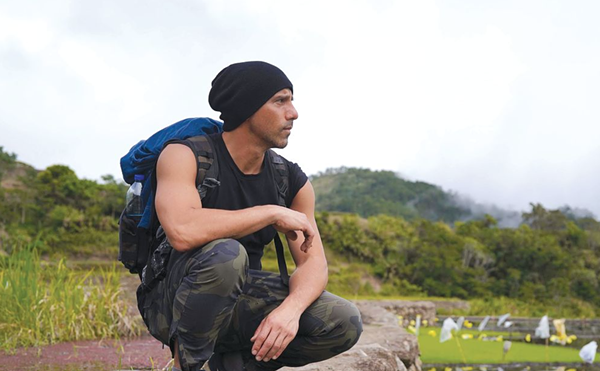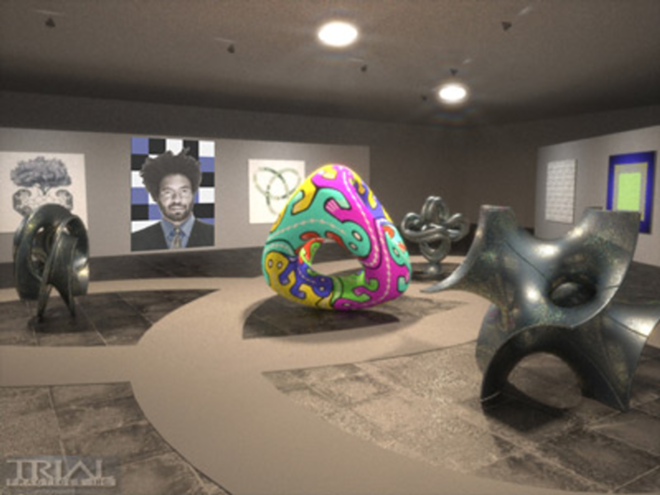
It's a starting point, but even the accolade "Renaissance man" doesn't quite do justice to Sarasota artist John Sims.
The 39-year-old has quilted with the city's population of Amish women. He's remixed words and sounds with DJ Spooky and famously lynched the Confederate flag at Gettysburg and in Tallahassee. He even plans to turn the island of Manhattan into a working clock sometime in the near future.
Sims's consuming passion is the esoteric discipline of mathematical art. His colorful quilts, based on a visual grid corresponding to the number pi, emerged from his desire to explore African expressions of math in craftwork patterns and symmetry. (When he rolled up to a Sarasota quilting shop with an armful of fabrics from Ghana, the Amish women inside went gaga; in exchange for some of his vibrant textiles, they offered to teach him to sew.) With Spooky, he created a trance-inducing recitation of the same endless number. In Manhattan, he'll stage 11 time-symbol sculptures in various neighborhoods and stagger performances around them. As for the Confederate flag-lynching — well, there's no particular mathematical root in that one, though it has generated a cloud of buzz that surrounds the artist, but Sims believes strongly that math has the power to symbolize injustice and inequality. (See his handmade chessboard with white kings that cannot be dethroned.)
"Mathematics gives us a starting platform for discussing complex ideas," Sims says. From nature to racial difference to global interdependency, math can help visualize the thorny concepts that characterize 21st-century life, he says. And he should know: Eight years ago, Ringling College of Art and Design hired him to teach visual mathematics — how to communicate ideas of quantity, relationship, symmetry and pattern through art and design — after he finished the core work on his doctorate in mathematics at Wesleyan University. Though he no longer rules the classroom, Sims remains a force in the Sarasota area, staging math art shows and promoting his passion–and completing his dissertation.
His latest project is a trio of exhibitions on math art; the first two, held in galleries at the University of South Florida in conjunction with a math conference, have closed, but an opportunity remains to see a third, smaller showcase at the Museum of Science and Industry and to hear Sims speak. On Tuesday, he'll present an original jazz composition based on pi and unveil a major undertaking, a virtual 3-D "museum" of mathematical art that he will make accessible online. (Eventually the museum will have its own URL, but for now check johnsimsprojects.com for updates.)
From where I'm standing, math art is a hard sell. There's a stereotype about right-brained types (like artists and arts writers) that probably has a grain of truth to it: Most of us have a downright phobia of the quantitative disciplines. Well, if anyone is ever going to persuade me to love math art, it's John Sims. In his pi quilts — one on view at MOSI, another at the Art Center Sarasota in a larger show on African-American quilting through the end of December — the idea of an infinite pattern is not only instantly intuitive, it's damn beautiful.
"For John, math art is on a much higher level" than simply illustrating numbers or concepts, says Kevin Dean, director of Ringling's Selby Gallery. "Math deals with the subject of absolute beauty," he says. Dean sat on the team of Ringling faculty who hired Sims, and soon afterward he began to help the new professor curate a math art exhibit for the Selby, which was held in 2002. The pair pulled together examples of the genre by a diverse group of artists, from unknown specialists to superstars like Sol LeWitt, Josef Albers, M.C. Escher and Frank Stella. The exhibit also took a pan-cultural take on math, showcasing African Bakuba patterns (which demonstrate an understanding of the Pythagorean theorem) and tessellations from Islamic art and design.
"Mathematics is a universal that gets beyond politics," Dean says. One visitor to the Selby, which has a reputation for politically charged shows, told Dean she was relieved to see an exhibit without an agenda. (And yet, an overarching theme is subtle but clear: Math is a cornerstone of our interconnected global heritage.) Organizing a national tour for the exhibit is one of Sims' current projects.
But his virtual museum of math art may expose more people to math art ideas than a traveling exhibit ever could. And some math-related artworks are best experienced in a simulated environment, Sims says. In virtual reality, visitors can shrink to the scale of an ant to roam around one of Carlos Sequin's knot-like sculptures. (Heck, it's a great idea for a lot of artworks — I'd love to be an ant on one of Brancusi's birds in space.)
Sims hopes his influence will help grow an international movement of math art that's not limited to academic mathematicians or the privileged classes. One of his requests during our interview is that we run a picture of him so people can see that a young black guy is behind all this enthusiasm about math and art.
"When people see who I am, they get a different idea about the subject," Sims says.
Sketchbook
Crafting Out Loud, my pick for Best Urban Craft Fair in the 2006 Best of the Bay issue (in fact, they're the Bay area's only urban craft fair), hits the big time Sun., Nov. 25, when the fair sets up shop at St. Petersburg's Museum of Fine Arts from 3 to 8 p.m. Look for at least a dozen crafty gals and guys hawking not-your-grandmother's crafts. Past events have showcased decorative bowls made of melted vinyl records, hip baby clothes, sassy découpage boxes and picture frames, silk-screened graphic T's and funky jewelry galore. Enjoy free admission to the museum, beer and wine for sale in the garden and free goodie bags for the first 50 visitors. For more information, go to craftingoutloud.com.
The eagle-eyed may have noticed a new gallery on one of downtown Tampa's recently redeveloped blocks. North Franklin Street, between Royal and Fortune streets, is now home to Orange Park Gallery (orangeparkgallery.com) near the popular Fly Bar, condos and other businesses. The gallery occupies a storefront in the Arlington, a restored early-20th-century brick building that previously housed the Arlington Hotel and a Badcock furniture store; the building was also a Gala Corina site in 2004. Orange Park currently features two shows: Samba Arte, woodblock prints by Cuban artist Israel Delmonte, and Figurative Expressions, paintings by Larissa Makeeva (Russia), Fauzie As'Ad (Indonesia) and Basil Watson (Jamaica).


